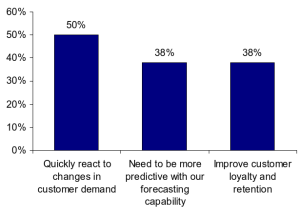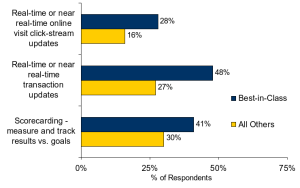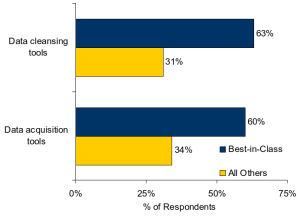
Retailers are increasingly focusing on the use of business intelligence as a tool to profile customers and increase loyalty. A survey of Aberdeen’s retail community in November 2007 revealed that business intelligence (BI) is the top technology that retailers will be focusing on in 2008.
In order to provide retailers with an actionable road map for understanding successful BI implementation and deployment methods, Aberdeen surveyed more than 200 retail companies to outline Best-in-Class strategies for improved performance. A full copy of the study can be found here.
Of the companies surveyed, 67 percent indicated they have already implemented and use BI, and 26 percent indicated plans to adopt a BI solution. The increased focus on BI among retailers is not unwarranted, as Aberdeen’s research reveals that utilization drives bottom line improvements:
- Twenty-five percent of Best-in-Class retail companies have increased their gross margin by over 10 percent over the past 12 months.
- Best-in-Class companies are almost two times as likely as Industry Average and are 14 times as likely as Laggards to have increased their gross margin over the past year.
Research Metrics
Aberdeen categorized all survey respondents based on a weighted average of each respondent’s performance across three key performance indicators (KPIs). For the purpose of this study, Aberdeen used annual percentage increase in year-over-year same-store sales, annual percentage increase in customer retention, and annual percentage increase in profit margin to benchmark respondent performance.
The top performing 20 percent of survey respondents were classified as “Best-in-Class,” the middle 50 percent were classified as “Industry Average,” and the remaining 30 percent were classified as “Laggards.” Based on the outlined KPIs, Best-in-Class companies showed the following performance:
- An average year-over-year same store sales increase of 11.7 percent.
- Ninety-two percent have increased their profit margin, with an average increase of 9.3 percent.
- A 12.2 percent increase in customer retention during the past 12 months.
Best-in-Class Differentiators
Among all respondents, including 50 percent of Best-in-Class companies, the top objective for implementing BI is the ability to quickly react to changes in customer demand. Following customer demand, Best-in-Class retail companies rely on their BI tools to help make more accurate business decisions and improve customer retention and loyalty (see Figure 1).
Based on these top pressures, there is a clear focus among Best-in-Class companies on improving intelligence across the enterprise to react to and better predict customer demand. Pleasing customers builds stronger relationships and turns one-time purchasers into long-term customers. In today’s highly competitive global landscape, the average consumer has many options, so maintaining and exceeding customer expectations is critical for a company’s continued success in establishing customer loyalty and cross-sell/up-sell opportunities.
In order to react more quickly to customer demand, Best-in-Class retail companies equip themselves with several performance management capabilities and technologies. Specifically, in order to manage their performance, 48 percent of Best-in-Class retail companies update their transaction data in real time, and 41 percent measure and track their actual results against departmental and corporate goals (see Figure 2).
Enabling real-time updates provides Best-in-Class retail companies with a significant competitive advantage. Today’s marketplace is dynamic, and changes occur rapidly and without warning. The ability to respond and take corrective action before the competition defines the difference between a market leader and a follower. In addition, the ability to conduct insightful analysis and derive value cannot occur without the right technologies to support a BI implementation (see Figure 3).
Best-in-Class companies have recognized that their top challenge involves data cleanliness, and are addressing this head-on through the use of data cleansing tools. They are also investing heavily in data acquisition — this involves both internal and external data to assist in gaining a greater understanding of customers.
In the long run, these investments can significantly lower the cost of BI implementations by ensuring data accuracy and acceptance by management and line-of-business end users. By consistently managing their data, these Best-in-Class retail companies are able to react more accurately to customer demand and improve their “time-to-market.” In turn, sales improvement can result as retail companies are able to take advantage of market fluctuations and opportunities.
Attaining Best-in-Class Performance
In order for retailers to derive actionable insights from their data for improved customer knowledge and loyalty, they need to ensure their data is reliable. Aberdeen’s research demonstrates that Best-in-Class retail companies are able to react more quickly to customer demand because they operate using real-time information that is cleansed and tracked against goals and previous performance.
Further, continued performance improvements require an understanding of where goals are not being met. Best-in-Class retail companies that have implemented scorecards are 2.8 times more likely to have increased their GMROI (gross margin return on investment) than all other respondents. Retailers are increasingly being challenged by new market forces, many of which are not being measured and tracked to the extent necessary to improve performance. Thus, for retailers to improve their performance, scorecards should be prioritized.
The recently published report, Business Intelligence in Retail: A Best-in-Class Roadmap for Performance Improvement provides more detail about how retail companies can improve their performance through their utilization of business intelligence.
Jeanette Keene is a senior research associate in the retail practice at the Aberdeen Group. She can be reached at [email protected].
David Hatch is a research director for the Aberdeen Group, where he focuses on the role of business intelligence in enabling the delivery of actionable information to the enterprise. He can be reached at [email protected].














































